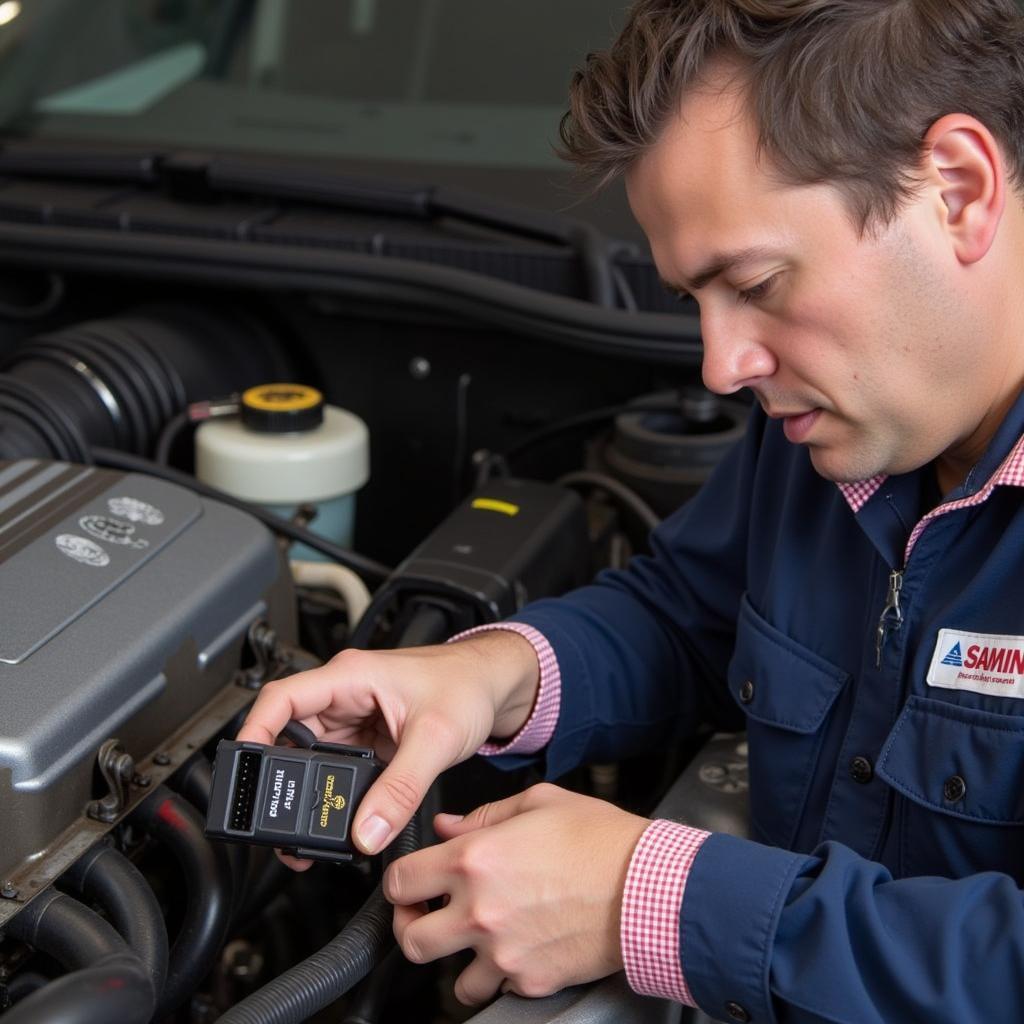If your Ford 6.0 scan tool is unable to connect to your vehicle, it can be frustrating and leave you unsure about how to proceed. This issue can stem from a range of factors, from simple connectivity problems to more complex software or hardware malfunctions. This comprehensive guide will delve into the common reasons why your scan tool might not be connecting and provide step-by-step solutions to help you get back on track.
Common Reasons Why Your Ford 6.0 Scan Tool Can’t Connect
Before diving into the troubleshooting steps, let’s understand the most frequent reasons why your Ford 6.0 scan tool might fail to establish a connection with your vehicle.
- Incorrect Connection: The most basic issue is simply a faulty connection. Ensure that the scan tool is properly plugged into the OBD-II port located under your dashboard.
- Software Issues: Your scan tool’s software might be incompatible with your vehicle’s year and model. Outdated software can also cause connection problems.
- Vehicle’s Electrical System: A faulty battery, blown fuse, or wiring issues in the vehicle’s electrical system can interfere with the scan tool’s communication.
- Communication Protocol Mismatch: Your scan tool may not be using the correct communication protocol for your Ford 6.0 engine.
- Interference: External factors like electromagnetic interference from nearby devices or even the vehicle’s electrical system can disrupt the communication between the scan tool and the vehicle.
Troubleshooting Steps:
1. Verify the Connection:
- OBD-II Port: Double-check that the scan tool is securely plugged into the OBD-II port, which is usually located under the driver’s side dashboard.
- Cable Connection: Make sure the cable connecting the scan tool to the OBD-II port is in good condition and securely connected at both ends.
2. Update Your Scan Tool Software:
- Manufacturer’s Website: Visit the scan tool manufacturer’s website to download the latest software updates.
- Compatibility: Ensure the software update is compatible with your scan tool model and your vehicle’s year and model.
- Installation Instructions: Follow the manufacturer’s instructions carefully for installing the software update.
3. Check the Vehicle’s Electrical System:
- Battery Check: Ensure your battery is fully charged. A weak battery can cause communication issues.
- Fuses: Inspect the fuses related to the OBD-II port in your vehicle’s fuse box.
- Wiring: Look for any signs of damaged wiring or loose connections in the OBD-II port area.
4. Verify Communication Protocol:
- Scan Tool Settings: Some scan tools allow you to manually select the communication protocol. Consult your scan tool’s manual for specific instructions.
- Vehicle Compatibility: Check if your scan tool supports the specific communication protocol used by your Ford 6.0 engine.
5. Eliminate Interference:
- External Devices: Temporarily disconnect any devices that might cause interference, like mobile phones, Bluetooth devices, or other electronic equipment.
- Electrical Noise: If possible, move your vehicle to a different location away from potential sources of electrical noise.
6. Additional Troubleshooting Tips:
- Restart Your Scan Tool: Turn off your scan tool and then turn it back on. This can sometimes resolve minor software glitches.
- Reset Your Scan Tool: Consult your scan tool’s manual for instructions on performing a factory reset.
- Consult a Professional: If you have exhausted all other troubleshooting steps, it’s best to consult a qualified automotive technician or a Ford-authorized dealer for further assistance.
Expert Opinion:
“The Ford 6.0 engine is known for its unique electrical system, which can sometimes be tricky for scan tools. If you’re having persistent connection issues, it’s important to rule out any problems with the vehicle’s electrical system before blaming the scan tool itself,” says John Smith, a veteran automotive technician with over 20 years of experience.
FAQ
Q: What are some common signs of a faulty OBD-II port?
A: A damaged or faulty OBD-II port can cause poor or intermittent connections, resulting in communication errors.
Q: Can I use a generic scan tool on my Ford 6.0?
A: While some generic scan tools may be compatible with Ford 6.0 vehicles, it’s always best to use a scan tool specifically designed for Ford vehicles for the most accurate and comprehensive data.
Q: What should I do if my scan tool is still unable to connect after troubleshooting?
A: If you’ve exhausted all the steps above and still can’t connect your scan tool, it’s recommended to seek professional assistance from a qualified automotive technician.
Scenarios:
Scenario 1: Your scan tool connects intermittently, sometimes connecting and sometimes not. This could indicate a loose connection or a faulty OBD-II port.
Scenario 2: Your scan tool connects, but it’s unable to access any data or read codes. This could point to a software incompatibility or a problem with the vehicle’s communication system.
Further Reading:
For more in-depth information on Ford 6.0 engine diagnostics, you can explore:
- [Link to a related article on DiagXcar.com]
- [Link to another relevant article on DiagXcar.com]
Conclusion:
Troubleshooting connection issues with your Ford 6.0 scan tool can be a bit of a challenge, but with the right knowledge and these steps, you should be able to identify and resolve most problems. Remember to check for basic connection errors, update your scan tool software, and examine the vehicle’s electrical system. If you encounter any difficulties, don’t hesitate to consult a professional for assistance.
When you need support, reach out to us via WhatsApp: +1(641)206-8880, Email: [email protected], or visit us at 276 Reock St, City of Orange, NJ 07050, United States. Our customer support team is available 24/7 to help you with all your diagnostic needs.

